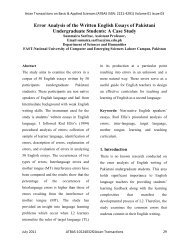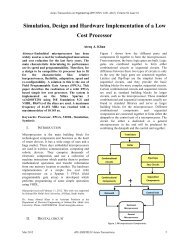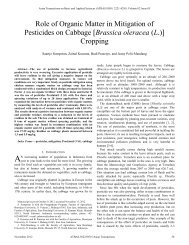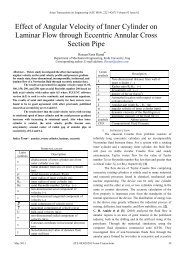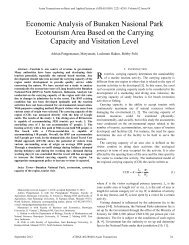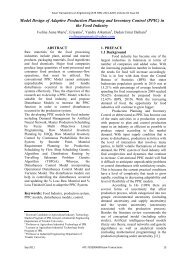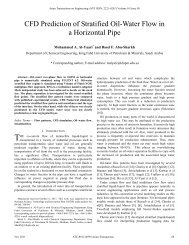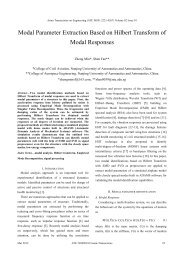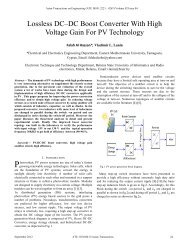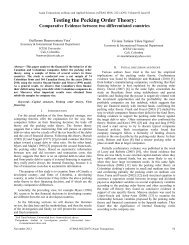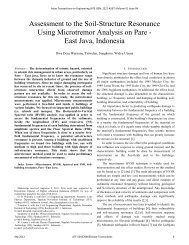Isolation of Prenylated Flavonoid from Ethyl Acetate Fraction of ...
Isolation of Prenylated Flavonoid from Ethyl Acetate Fraction of ...
Isolation of Prenylated Flavonoid from Ethyl Acetate Fraction of ...
- No tags were found...
You also want an ePaper? Increase the reach of your titles
YUMPU automatically turns print PDFs into web optimized ePapers that Google loves.
Asian Transactions on Basic and Applied Sciences (ATBAS ISSN: 2221-4291) Volume 02 Issue 06From HPLC chromatogram, it shows that the compoundalmost pure (compound 1) and identified using NMR and MS.From MS data, compound 1 has molecular weight 408. Theanalysis <strong>of</strong> its NMR data and comparison with referenceshowed in Table 1. From the 13 C-NMR spectrum, compound 1indicated 25 carbons, including 8 sp 2 methine carbons, 4methylene carbons, 3 methyl groups, and 10 quartenerycarbons.Table 1. Comparison <strong>of</strong> 13 C and 1 H NMR assignment between compound 1and referenceFrom NMR spectrum, MS data, and comparison withprevious spectral data [16];[17];[18], compound 1 wasidentified as prenylated flavonoid, named 1-(2,4-dihydroxyphenyl)-3-[8-hydroxy-2-methyl-2-(4-methyl-3-pentenyl)-2H-1-benzopyran-5-yl]-1-propanone (Figure 3). In[18], this compound was isolated by general gravitationcolumn chromatography that needs various solid and mobilephase system for separations and purifications beforeobtaining the pure compound 1. Therefore this suggests theadvantage <strong>of</strong> using CCC system for isolation <strong>of</strong> compound.C No.13 C and 1 H NMR assignment <strong>from</strong>compound 1δ C (ppm)δ H (ppm)(H, multiplicity, J inHz)13 C and 1 H NMRassignment <strong>from</strong> reference[16]δ C (ppm)δ H (ppm)(mult., J inHz)1 165.20 165.152 103.62 6.38 (1H, d, 2.45) 103.51 6.37 (2.0)3 163.48 163.1446.37 (1H, dd, 2.45;6.34 (8.8;108.27 8.5) 107.97 2.0)5 132.45 7.54 (1H, d, 8.5) 132.27 7.55 (8.8)6 113.66 113.597 204.14 203.898 39.77 3.1 (2H, q) 39.65 3.08 (m)9 26.66 2.9 (2H, m) 26.49 2.97 (m)10 128.08 127.9111 121.29 6.60 (1H, d, 8.5) 121.14 6.61 (8.2)12 114.71 6.72 (1H, d, 8.5 ) 114.53 6.73 (8.2)13 143.11 143.0214 139.72 139.5615 119.22 119.0316 119.49 6.54 (1H, d, 9.8) 119.36 6.54 (10.2)17 130.30 5.63 (1H, d, 9.8) 130.12 5.63 (10.2)18 78.9 78.761940.77 1.70 (m)40.89 1.7 (2H, m)20 22.94 2.09 (2H, m) 22.80 2.08 (m)21 123.99 5.08 (1H, t) 123.84 5.08 (7.0)22 132.10 131.9523 25.80 1.66 (3H, s) 25.66 1.65 (bs)24 17.78 1.57 (3H, s) 17.64 1.56 (bs)25 26.20 1.38 (3H, s) 26.07 1.38 (s)1-OH 12.85 (1H, s) 12.81 (s)3-OH7.20 (bs)13-OH5.58 (bs)* Spectra compound 1 recorded at 500 MHz for 1 H spectrum and 125 MHzfor 13 C spectrum in CDCl 3 and reference’s spectra recorded at 500 MHz. Thevalues are in ppm and J values (Hz) in parentheses. Abbreviations for NMRsignal are as follows: s = singlet, d = doublet, and t = triplet.The 1 H-NMR spectra suggested the existence <strong>of</strong> two aromaticrings, ring A and B. At ring A have three proton aromatics,revealed a clear AMX system as indicated by the protonresonances at 6.38 (H-3’, d, J 2.45 Hz) and 6.37 ppm (H-5’,dd, J 2.45 Hz and 8.5 Hz) and at 7.54 ppm (H-6’, d, J 8.5 Hz)and 6.37 ppm (1 H, dd, J 2.45 Hz and 8.5 Hz). The down fieldchemical shift at 12.85 ppm (s) indicated the presence <strong>of</strong>hydroxyl group formed a hydrogen bond with a carbonylgroup (C-1) at 204.14 ppm. The multiplicities <strong>of</strong> carbons wereassigned by the DEPT-135 experiment.HO32423OHA2216O716Fig. 3. Molecular Structure Compound Isolate A [1-(2,4-dihydroxyphenyl)-3-[8-hydroxy-2-methyl-2-(4-methyl-3-pentenyl)-2H-1- benzopyran-5-yl]-1-propanone].1910C181514IV. CONCLUSIONSCounter-current chromatography technique is moreefficient for compound isolation <strong>from</strong> ethyl acetate fraction <strong>of</strong>A. altilis leaves compare to column chromatography because itdoesn’t need a lot <strong>of</strong> purification step.Based on NMR spectra, MS data, and compared withprevious published spectral data, compound 1 <strong>from</strong> ethylacetate extract <strong>of</strong> A. altilis leaves was identified as aprenylated flavonoid, [1-(2,4-dihydroxyphenyl)-3-[8-hydroxy-2-methyl-2-(4-methyl-3-pentenyl)-2H-1- benzopyran-5-yl]-1-propanone].ACKNOWLEDGMENTThis work is collaboration research between ZhejiangUniversity and Indonesian Institute <strong>of</strong> Sciences (LIPI). Wealso thanks to Pr<strong>of</strong>. Yuanjiang Pan and his group member forfacilitating this research.BO2513OHJanuary 2013 ATBAS-30216065©Asian Transactions 8
Asian Transactions on Basic and Applied Sciences (ATBAS ISSN: 2221-4291) Volume 02 Issue 06REFERENCES[1] Eisai PT., Medical Herb Index in Indonesia.1986.[2] T. Nomura, Y. Hano, “Isoprenoid substituted phenolic compounds <strong>of</strong>moraceous plants”, Nat. Prod. Rep., 11, 205-218, 1994.[3] T. Nomura, Y. Hano, M. Aida, “Isoprenoid substituted flavonoids <strong>from</strong>Artocarpus plants (Moraceae)”, Heterocycles, 47, 1179-1204, 1998.[4] M-I Chung, H-H Ko, M-H Yen, C-N Lin, “Artocarpol A, a novelconstituent with potent anti-inflammatory effect, isolated <strong>from</strong>Artocarpusrigida”, Helv Chim Acta, 83: 1200-1204, 2000.[5] C-N Lin, C-M Lu, H-C Lin, S-C Fang, B-J Shieh, M-F Hsu, J-P Wang,F-N Ko, C-M Teng, “Novel antiplatelet constituents <strong>from</strong>formosanMoraceous plants”, J. Nat Prod., 59 (9): 834-838, 1996.[6] F.N Ko, Z.J. Cheng, C.N Lin, C.M. Teng, “Scavenger and antioxidantproperties <strong>of</strong> prenylflavones isolated <strong>from</strong> Artocarpus heterophyllus”,Free Radical Biol Med, 25:160-168, 1998.[7] M. Sato, S. Fujiwara, H. Tsuchiya, T. Fujii, M. Linuma, H. Tosa, Y.Ohkawa, “Flavones with antibacterial activity against cariogenicbacteria”, J. Ethnopharmacol, 54: 171-176, 1996.[8] M.S.J Nascimento, H. Cidade, M. Pinto. A. Kijjoa, “Anticomplementaryactivity <strong>of</strong> prenylated flavones <strong>from</strong> Artocarpus elasticus”, Pharm.Pharmacol. Lett,. 7: 135, 1997.[9] K. Shimizu, R. Kondo, K. Sakai, S.H. Lee, H. Sato, “The inhibitorycomponents <strong>from</strong> Artocarpus incisus on melanin biosynthesis”, PlantaMed. 64, 408-412, 1998.[10] K. Shimizu, M. Fukuda, R. Kondo, K. Sakai, “The 5 alpha-reductaseinhibitory components <strong>from</strong> heartwood <strong>of</strong> Artocarpusincisus: structureactivityinvestigation”, Planta Med., 66 (1): 16-9, 2000.[11] K. Likhitwitayawuid, B. Sritularak, “A new dimericstilbene withtyrosinase inhibitory activity <strong>from</strong> Artocarpus gomezianus”, J. Nat.Prod., 64, 1457-1459, 2001.[12] K. Shimizu, R. Kondo, K. Sakai, “Inhibition <strong>of</strong> tyrosinase by flavonoids,stilbenes and related 4-substituted recorcinols: structure-activityinvestigations”, Planta Med., 66 (1): 11-5, 2000[13] E.W.M. Verheij, R.E. Coronel (Eds.), Plant resources <strong>of</strong> South-EastAsia, No.2, edible fruit and nuts. PROSEA, Bogor, Indonesia, pp 79-96,1992.[14] H. Guzlek, I.I.R. Baptista, P.L.Wood, and Livingston, A. 2010.A novelapproach to modelling counter-current chromatography.J.Chromatography A, 1217, p 6230-6240.[15] McLean, S., Reynolds, W.F., Tinto, W.F., Chan, W.R., Shepherd, V.,1996. Complete13 C and1 H spectral assignments <strong>of</strong> prenylatedflavonoids and a hydroxy fatty acid <strong>from</strong> the leaves <strong>of</strong> CaribbeanArtocarpus communis. Magn.Reson. Chem. 34, 719-722.[16] Koshihara, Y., Fujimoto, Y., and Inoue, H., 1988. A new 5-lipoxygenaseselective inhibitor derived <strong>from</strong> Artocarpus communis strongly inhibitsarachidonic acid-induced ear edema. BiochemPharmacol. 37(11), 2161-2165.[17] Wang, Y., K. Xu, L. Lin, Y. Pan and X Zheng. 2007. Geranylflavonoids <strong>from</strong> the leaves <strong>of</strong> Artocarpus altilis. Phytochemistry 68:1300-1306.S. Fajriah, was born in Serang, Banten, Indonesia, February 5, 1981, postgraduated <strong>of</strong> Chemistry, Faculty <strong>of</strong> Mathematics and Natural Sciences,Padjadjaran University, Bandung, West Java, Indonesia, graduated in 2003.Master degree <strong>of</strong> Chemistry, Faculty <strong>of</strong> Mathematics and Natural Sciences,Indonesia University, graduated in 2011.Position as reseacher at Natural Product, Food, and PharmaceuticalDivision <strong>of</strong> Research Center for Chemistry, Indonesian Institue <strong>of</strong> Sciences(LIPI) since 2005.January 2013 ATBAS-30216065©Asian Transactions 9



